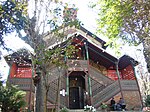St. Sergius Institute

The St. Sergius Orthodox Theological Institute (French: Institut de théologie orthodoxe Saint-Serge) in Paris, France, is a private university of higher education in Orthodox theology. Founded in 1925 by a group led by Metropolitan Eulogius Georgiyevsky, historian, theologian, and last Minister of Religious Affairs of the Russian Provisional Government, Anton Kartashev, Lev Liperovsky and Mikhail Ossorguine, with the active support of Nobel Peace Prize recipient John Mott. It is under the canonical jurisdiction of the Archdiocese of Russian Orthodox churches in Western Europe under the omophorion of the Russian Orthodox Church. The institute has been in conformity with French legislation and the norms of European university education since its earliest years and is accredited by the Académie de Paris to deliver bachelor, masters and doctoral degrees. The mission of the institute is to form educated priests and laypeople, intending them to serve actively the Orthodox Church and representing it in ecumenical dialogue as well as in the religious and cultural life of their own country.
Excerpt from the Wikipedia article St. Sergius Institute (License: CC BY-SA 3.0, Authors, Images).St. Sergius Institute
Rue de Crimée, Paris 19th Arrondissement (Paris)
Geographical coordinates (GPS) Address Nearby Places Show on map
Geographical coordinates (GPS)
| Latitude | Longitude |
|---|---|
| N 48.88388889 ° | E 2.38444444 ° |
Address
Rue de Crimée 95
75019 Paris, 19th Arrondissement (Paris)
Ile-de-France, France
Open on Google Maps











